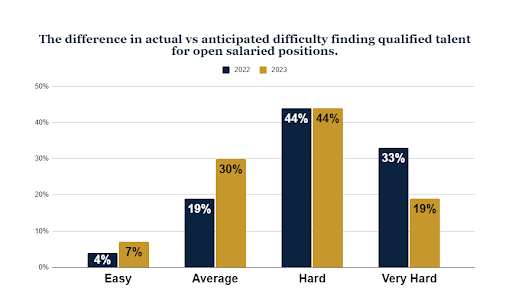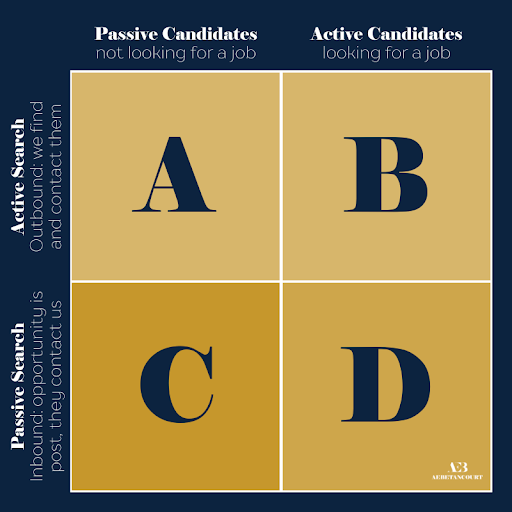Hiring top talent in this day and age is a challenge. It will become a much more difficult challenge as recession looms, compensation rises, and business needs continue to change and evolve in a tight labor market. You’re not imagining these things and you’re certainly not alone in facing these hiring challenges. Economic uncertainty always prompts more cautious hiring decisions and puts more pressure on an organization’s recruitment capabilities.
This blog will recap an insurance-focused webinar hosted and presented by our Chief Operating Officer Brian Eggleston. Brian overviewed some of the specific hiring challenges that the insurance industry is facing, along with some of the myths and missteps that organizations take with their hiring strategies. Finally, Brian shared some tips on creating an effective hiring strategy that includes considerations that qualified candidates are looking for.
Employment and Workplace Trends
Before we get into some of the application-based information, let’s take a look back at the state of hiring and what kind of context current trends can provide.
First, hiring overall has slowed, and turnover levels have not decreased. Job quits have remained at record levels since early 2021. Companies with less than 250 employees continue to post the highest levels of those job quits. Another major change in employment and workplace trends over the last three to four years is anticipating employees' wants and needs, and responding to the way they change. Organizations are trying to identify key motivators for attracting and retaining top talent, which could mean shifting from purpose and mission-focused work to better work-life balance to compensation and back to work-life balance.
For a more industry-specific perspective, in our State of Hiring report, we asked organizations how difficult it was to find qualified talent for open positions in 2022, and then asked how difficult they anticipated hiring to be in 2023. Last year, more than 75% of the responding insurance agencies hired for them as hard or very hard. And 63% of agencies anticipated that in 2023, they would face similar difficulties.

Another major challenge that the insurance industry faces is an aging workforce, creating a double-sided issue that organizations have to overcome. First, the age of your workforce can now span four to five generations, and each has its own needs and expectations. And second, a large percentage of the working population within the insurance industry is retiring which opens up talent gaps and requires more intentional succession planning from organizations. There is a unique need within the insurance industry because of the wide breadth of institutional knowledge among well-established individuals. Unfortunately, most organizations aren't equipped to create the succession plans they require.
So, what made hiring so difficult for these insurance organizations? The overwhelming majority revealed that finding qualified talent was their biggest challenge. And that reason was identified two and a half more times than the closest factor, which was an organization’s budget.

Your Hiring Strategy
The hiring process can feel arduous when it’s difficult to find top talent, especially if your organization doesn’t have a strategy.
Improving the hiring process can help organizations to avoid some common pitfalls and mistakes. One thing to remember: hope is not a strategy. To create a hiring process that meets all of the unique needs of your agency, you need to develop a structured hiring process, reestablishing an effective sourcing strategy, which includes determining where exactly you should be looking for top talent, and knowing why you’re hiring in the first place.
A Structured Hiring Process
To develop a more structured hiring process, you need to start by answering a few basic questions: Who? What? How? When? and Why? Let’s break that down further:
-
Who?
First, determine who will be doing the interviews. Do you want other producers to join in on the process to see if your candidates will mesh with the team or get a better idea of how they will fit into your culture? Ultimately, you need to know who is going to be the final decision maker which can help to improve the efficiency and effectiveness of the overall process. -
What?
Next, be sure to know fully what the role entails. What is the job description — which is different from a job posting — and the expected outcomes for the position? What are some of the key markers of success in the role and what will it take a candidate to get there? Now is the time to get very detailed about candidate expectations and how they will be compensated. - How?
Another very crucial part of structuring your hiring process is addressing the actual interview process. How many interviews will a candidate have? How will the interviews be formatted? Does your organization need more one-on-one interviews or group settings? Will interviews happen in person or virtually? And most important, how will you collect feedback? -
When?
Map out the timeframe to determine the overall pace — remember, you want to avoid death by interview, so be mindful of the process and what it takes to complete to avoid candidates losing momentum. -
Why?
Finally, why should you answer all these questions and create a process? To avoid errors and inconsistencies. A consistent process will yield consistent results — so how can you be more strategic in filling the funnel with top talent?
Sourcing Strategy
A structured hiring process means you’ll have a sourcing strategy that can attract and recruit both active and passive candidates. This is crucial to expanding your talent pool and ensuring you find the perfect fit for the job.
We break down the sourcing strategy into two types: active and passive. Active candidates are already searching and applying for jobs. Passive candidates are currently employed but not actively looking for another job. An active search means directly reaching out to candidates regarding opportunities. In contrast, conducting a passive search means simply placing your open opportunities in places where candidates are likely to see them.

Use your time and resources most efficiently by actively searching for both passive and active candidates. Best practice reveals that recruitment efforts in every quadrant will maximize sourcing and strategic searches will proactively target passive candidates, and passively target active candidates. Coupled with maintaining an ongoing referral system through your current employees, you are well on your way to a highly effective hiring process.
Review Your Job Posting
Now that you have a sourcing strategy for both active and passive candidates, next you need to review your job posting to tailor the information to the candidate you’re looking to attract. And we are seeing more traction with job postings than in previous years, which is great. However, when you’re making a job posting, consider utilizing standard versus specialized job titles.
For example, in the insurance industry, a salesperson is called a producer. However, if you decide to do a producer search for individuals in Chicago you may wind up with a candidate pool of 236 people. From a job posting standpoint, that reveals that many people may not call themselves producers or they’re not searching for a role with that job title specifically. However, if you broaden the terminology to “insurance sales” that may garner search results of over 7,000 individuals. What does this mean? Don't needlessly limit yourself by the terminology you're using within your job postings.
Where Should You Look?
Your process has been revamped, your job posting looks great, and you have a strategy for how to source candidates — now it’s time to review your actual sourcing methods.
Place your postings on relevant high-traffic sites and take advantage of social media, especially LinkedIn, it's the top professional networking site. Don’t forget about job boards, carriers, vendors, and most importantly, your employees. They're always the best source. Creating a referral program within your organization and incentivizing employees to refer from within their networks might expand your candidate pool of top talent.
Know Your Why
The last thing important aspect of structuring your hiring process is knowing your why. This is done in two parts: First, knowing where and how you’re going to find and look for talent, and second, creating a compelling opportunity that will attract the talent. This is where your employee value proposition (EVP) comes into play.
Your EVP is a key driver of talent acquisition. It helps to outline the value your employees gain from working at your organization rather than your competitors. So, now is the time to define your EVP and share that with everyone in your company, ensuring that everyone can articulate some of the key benefits.
Recruiting Producers: Inside the Industry
Recruiting talents within the industry requires compelling benefits and drivers that would motivate a producer to leave their agency, especially if the individual has been working in the industry for some time. Some consider that might help recruit producers include:
- Better compensation, higher base salary, or higher commission splits
- Equity/ownership opportunities
- The available book of business
- Cross-selling opportunities
- Account size
- Market access/more carrier access
- Leadership opportunities
- Clear sales process
- Competitive business advantages
- Additional services and operational resources
Recruiting Producers: Outside the Industry
When recruiting producers from outside of insurance, emphasizing the industry’s sales opportunities is key. The reoccurring revenue within this industry is unlike most others. Some other factors that could help recruit producers outside the industry include:
- Better compensation that includes residual income within a recession-proof industry
- Opportunities to build relationships with decision-makers
- No territory restrictions
- Flexible work-life balance
- Ability to specialize in any industry
- Client support and resources
- Consultative sales process
- Community support
Recruiting Account Managers
Beyond producers, when searching for qualified account managers you will need to assess your recruitment efforts to ensure your promoting the most compelling reasons for individuals within this role to move agencies. Examples would include:
- Better compensation, featuring higher base salaries or unique bonus structures
- Positive culture perceptions
- Clearer service process
- Leadership opportunities
- Account size
- More complex accounts
- Hybrid and/or flexible schedules
Q & A's from the Webinar
We received several great questions from webinar attendees on how to “insure” their talent needs were covered, and tips for developing a structured hiring process, sourcing strategy, and more. Take a look to see what was asked.
- What is the average time it takes to hire a quality employee?
- What is the “sweet spot” for the number of interviews to schedule with a candidate?
- What are the different interview styles that are recommended when hiring for personal lines account managers and/or commercial line producers?
- How useful are personality assessments to the hiring process?
- Does AEB have a source for work sample tests?
To view the answers to these questions, check out the webinar starting at 25:48.
Do you have questions about creating a more structured hiring strategy? Access our resource on the recruitment process for more information and guidance.


.png)
.png)
.png)
.png)
.png)


